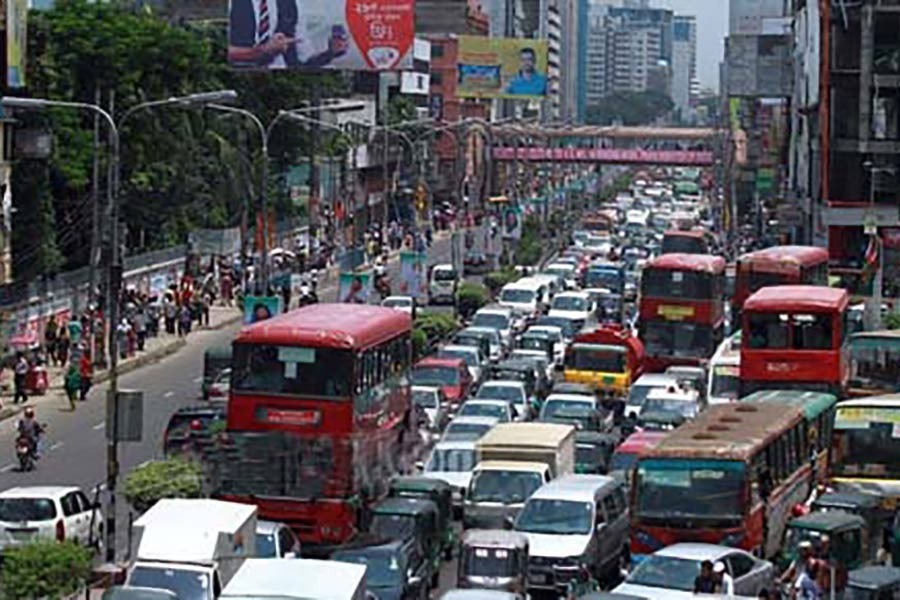
Published :
Updated :

The horrendous traffic jams in the capital city is back again. During the early stage of the spread of coronaviras pandemic, traffic jam was to some extent tolerable. But now, with the pandemic still in progress, the same old picture of traffic indiscipline is back again.
Over more than a decade, the government spent a hefty amount of money on the traffic signal system in the capital. The money went down the drain as the system became ineffective within days. And traffic police had to control vehicular movement with hand signals at all intersections in the capital.
The government initiated a new project in 2013 for installing countdown timers alongside the set of lights at intersections. Trials of the timers were reportedly done twice at some points. But the move ended up in failure. The congestion otherwise increased, prompting both the city corporation authorities to delay implementation of the new system.
When the digital timer was launched this timeagain, it had also an option for manually overriding the timing for the lights in case of increase in traffic volume at an intersection. Instant Power Supply (IPS) was also installed to keep the system operational in case of power cuts. But nothing had worked indeed and the operation of the new system was abandoned again. Of late, manual traffic signal system resumed which, to some extent, calmed down the situation.
Transport analysts say countdown digital timers were not necessary for a city like Dhaka. It is required when the general traffic signal mechanisms become successful. It is just a supplementary mechanism of traffic signal system, not an alternative. Neither signal lights nor timers will be effective in a city where motorists and drivers are least bothered about the signals.
After the previous failure of the system, DMP and the city corporations started accusing each other of the lapses in the system. Without synchronising each and every traffic light, it was not understood as to what led them to go for such a dubious launch so suddenly.
In a synchronised signal system, a commuter who gets a green signal at, for example, Shahbagh will pass through green lights at subsequent intersections, including those at Sheraton point, Sonargaon circle, Farmgate etc. But this did not happen. As a result, lack of synchronisation caused traffic to come to a complete halt during rush hours at every intersection.
On the contrary, such automated signalling system is not the whole answer to Dhaka's insurmountable traffic woes. Tangible improvements can be made if authorities establish proper system for traffic and parking management as well as small scale improvement to reduce existing problems.
For the new system to work, people have to be made aware through widespread media campaign. The violators of the traffic rules need to be penalised. Unfortunately, the city does not possess adequate number of close circuit cameras to spot the violators.
If all the drivers and vehicle users have national ID cards, it must not be difficult to spot them if close circuit cameras at traffic lights work and central control process each case meticulously. There is no way that anyone breaching any traffic law can escape.
Without mass transit systems such as the metro rail, elevated expressway and bus rapid transit, a significant change in the traffic situation of Dhaka is unlikely to occur. Certain infrastructural inadequacies need to be effectively addressed if the city is to overcome the crippling traffic congestion.
Until now such a strategy seems to be missing as the government has otherwise appeared to move from one experiment to another in its bid to ease the traffic situation, which, many believe, has aggravated the situation.
Traffic management must be streamlined in order to deal with the endless traffic snarls. The authorities also need to realise that the enforcement of rules is a prime requisite to bringing order in traffic and thus ensuring safety of passengers and pedestrians alike.
If the law is applied and an effective traffic management system is in place, the situation is expected to improve, at least to a tolerable level. In the bigger cities of the world, to mention, traffic laws are strictly enforced and the situation is controlled by adopting realistic planning.


 For all latest news, follow The Financial Express Google News channel.
For all latest news, follow The Financial Express Google News channel.